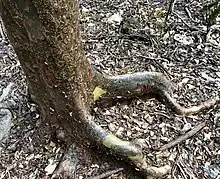| Commiphora aprevalii | |
|---|---|
 | |
| Commiphora aprevalii in Ankarana Reserve, Madagascar | |
| Scientific classification | |
| Kingdom: | Plantae |
| Clade: | Tracheophytes |
| Clade: | Angiosperms |
| Clade: | Eudicots |
| Clade: | Rosids |
| Order: | Sapindales |
| Family: | Burseraceae |
| Genus: | Commiphora |
| Species: | C. aprevalii |
| Binomial name | |
| Commiphora aprevalii Guillaumin, Andre (1909) | |
| Synonyms | |
|
Balsamea aprevallii Baill. | |
Commiphora aprevalii, known locally as the Vazaha tree, is a member of the Burseraceae family endemic to Madagascar. In Malagasy, "Vazaha" means stranger or foreigner; the name likens the characteristic peeling bark to the peeling skin of a badly sunburnt tourist.[1]
The Vazaha tree is a deciduous succulent, which tolerates dry season conditions by shedding its leaves and storing water in its trunk and branches. The peeling bark is thought to help the trunk and branches photosynthesize.
The leaves of C. aprevalii are pinnate with lanceolate leaflets. The species is a close relative of the myrrh tree, Commiphora myrrha.[2]
The species was named after André Revillon d'Apreval, a French botanical illustrator active at the turn of the twentieth century.[3]
Another member of the Burseraceae family from across the world, the gumbo-limbo, shares both the peeling bark and the teasing nickname “tourist tree”. [4]
Ecology
Commiphora aprevalii occurs on the island of Madagascar from sea level to 999 meters in dry and sub-arid climates.[5]
References
- ↑ "Vazaha Tree". What's Up Science?. Retrieved 17 April 2021.
- ↑ "Commiphora aprevalii". RarePalmSeeds.com. Retrieved 17 April 2021.
- ↑ "Commiphora aprevalii Baill". The Plant List. Retrieved 17 April 2021.
- ↑ "Floridata". floridata.com. Retrieved 2021-04-28.
- ↑ "Commiphora aprevalii Guillaumin". Tropicos.org. Retrieved 17 April 2021.